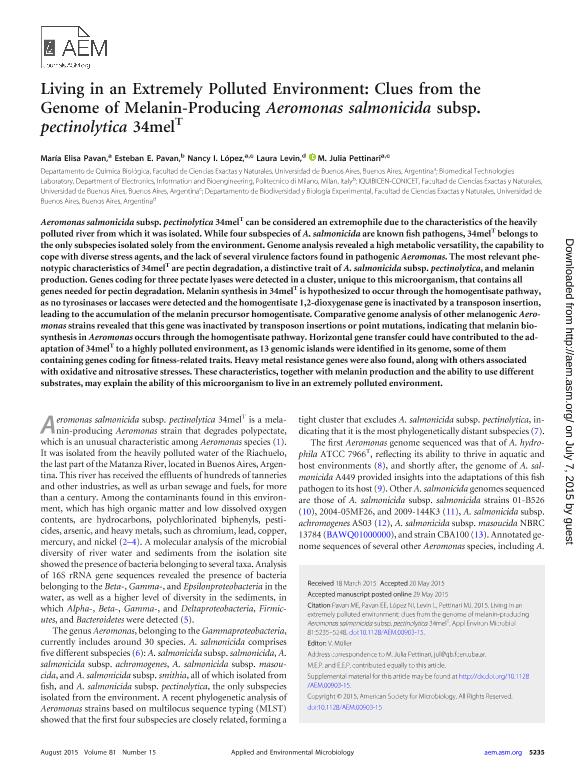Mostrar el registro sencillo del ítem
dc.contributor.author
Pavan, María Elisa

dc.contributor.author
Pavan, Esteban E.

dc.contributor.author
Lopez, Nancy Irene

dc.contributor.author
Levin, Laura Noemi

dc.contributor.author
Pettinari, Maria Julia

dc.date.available
2017-05-10T16:02:46Z
dc.date.issued
2015-05-29
dc.identifier.citation
Pavan, María Elisa; Pavan, Esteban E.; Lopez, Nancy Irene; Levin, Laura Noemi; Pettinari, Maria Julia; Living in an Extremely Polluted Environment: Clues from the Genome of Melanin-Producing Aeromonas salmonicida subsp. pectinolytica 34melT; American Society for Microbiology; Applied And Environmental Microbiology; 81; 15; 29-5-2015; 5235-5248
dc.identifier.issn
0099-2240
dc.identifier.uri
http://hdl.handle.net/11336/16203
dc.description.abstract
Aeromonas salmonicida subsp. pectinolytica 34melT can be considered an extremophile due to the characteristics of the heavily polluted river from which it was isolated. While four subspecies of A. salmonicida are known fish pathogens, 34melT belongs to the only subspecies isolated solely from the environment. Genome analysis revealed high metabolic versatility, the capability to cope with diverse stress agents, and the lack of several virulence factors found in pathogenic Aeromonas. The most relevant phenotypic characteristics of 34melT are pectin degradation, a distinctive trait of the pectinolytica subspecies, and melanin production. Genes coding for three pectate lyases were detected in a cluster unique for this microorganism, that contains all genes needed for pectin degradation. Melanin synthesis in 34melT is hypothesized to occur through the homogentisate pathway, as no tyrosinases or laccases were detected, and the homogentisate 1,2-dioxygenase gene is inactivated by a transposon insertion, leading to the accumulation of the melanin precursor homogentisate. Comparative genome analysis of other melanogenic Aeromonas revealed that this gene was inactivated by transposon insertions or point mutations, indicating that melanin biosynthesis in Aeromonas occurs through the homogentisate pathway. Horizontal gene transfer could have contributed to the adaptation of 34melT to a highly polluted environment, as thirteen genomic islands were identified in its genome, some of them containing genes coding for fitness related traits. Heavy metal resistance genes, along with others associated to oxidative and nitrosative stress were also found. These characteristics, together with melanin production and the ability to use different substrates, could explain the capability of this microorganism to live in an extremely polluted environment.
dc.format
application/pdf
dc.language.iso
eng
dc.publisher
American Society for Microbiology

dc.rights
info:eu-repo/semantics/openAccess
dc.rights.uri
https://creativecommons.org/licenses/by-nc-sa/2.5/ar/
dc.subject
Melanin
dc.subject
Pectin Degradation
dc.subject
Aeromonas Salmonicida
dc.subject
Polluted Environment
dc.subject
Bacterial Genome
dc.subject.classification
Bioquímica y Biología Molecular

dc.subject.classification
Ciencias Biológicas

dc.subject.classification
CIENCIAS NATURALES Y EXACTAS

dc.title
Living in an Extremely Polluted Environment: Clues from the Genome of Melanin-Producing Aeromonas salmonicida subsp. pectinolytica 34melT
dc.type
info:eu-repo/semantics/article
dc.type
info:ar-repo/semantics/artículo
dc.type
info:eu-repo/semantics/publishedVersion
dc.date.updated
2017-05-02T18:18:50Z
dc.journal.volume
81
dc.journal.number
15
dc.journal.pagination
5235-5248
dc.journal.pais
Estados Unidos

dc.journal.ciudad
Washington
dc.description.fil
Fil: Pavan, María Elisa. Universidad de Buenos Aires. Facultad de Ciencias Exactas y Naturales. Departamento de Química Biológica; Argentina
dc.description.fil
Fil: Pavan, Esteban E.. Politecnico Di Milano; Italia
dc.description.fil
Fil: Lopez, Nancy Irene. Consejo Nacional de Investigaciones Científicas y Técnicas. Centro Científico Tecnológico Conicet - Patagonia Norte. Centro de Investigaciones en Toxicología Ambiental y Agrobiotecnología del Comahue. Laboratorio de Investigaciones Bioquímicas y Químicas del Ambiente | Universidad Nacional del Comahue. Facultad de Ciencias Agrarias. Centro de Investigaciones en Toxicología Ambiental y Agrobiotecnología del Comahue. Laboratorio de Investigaciones Bioquímicas y Químicas del Ambiente; Argentina. Universidad de Buenos Aires. Facultad de Ciencias Exactas y Naturales. Departamento de Química Biológica; Argentina
dc.description.fil
Fil: Levin, Laura Noemi. Universidad de Buenos Aires. Facultad de Ciencias Exactas y Naturales. Departamento de Biodiversidad y Biología Experimental; Argentina
dc.description.fil
Fil: Pettinari, Maria Julia. Consejo Nacional de Investigaciones Científicas y Técnicas. Centro Científico Tecnológico Conicet - Patagonia Norte. Centro de Investigaciones En Toxicología Ambiental y Agrobiotecnología del Comahue. Laboratorio de Investigaciones Bioquímicas y Químicas del Ambiente | Universidad Nacional del Comahue. Facultad de Cs.agrarias. Centro de Investigaciones En Toxicología Ambiental y Agrobiotecnología del Comahue. Laboratorio de Investigaciones Bioquímicas y Químicas del Ambiente; Argentina. Universidad de Buenos Aires. Facultad de Ciencias Exactas y Naturales. Departamento de Química Biológica; Argentina
dc.journal.title
Applied And Environmental Microbiology

dc.relation.alternativeid
info:eu-repo/semantics/altIdentifier/url/http://aem.asm.org/content/81/15/5235.long
dc.relation.alternativeid
info:eu-repo/semantics/altIdentifier/doi/http://dx.doi.org/10.1128/AEM.00903-15
Archivos asociados
